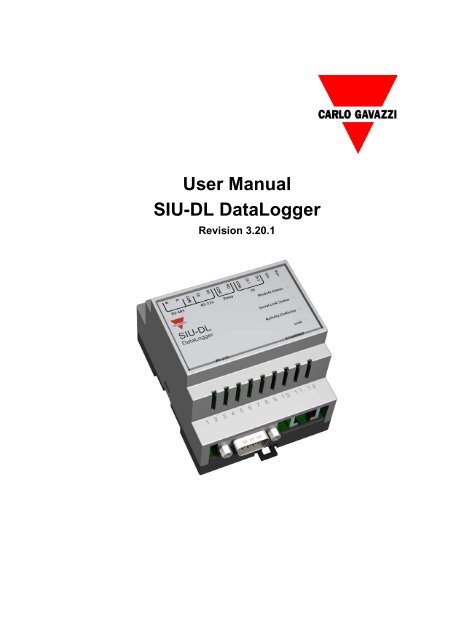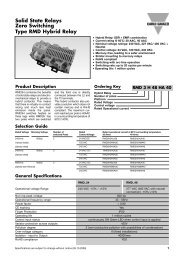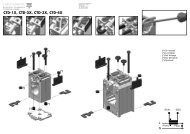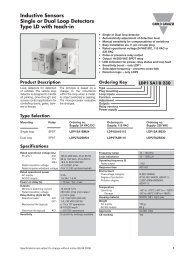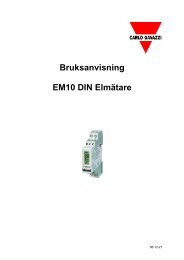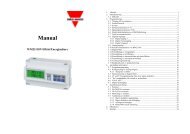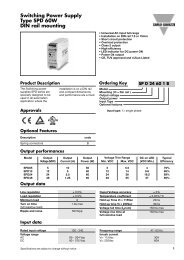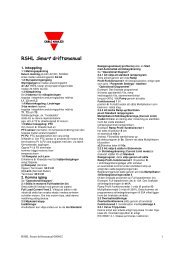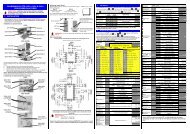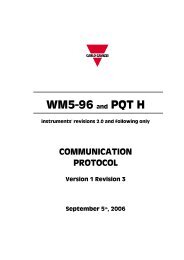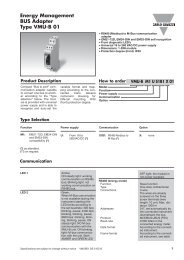User Manual SIU-DL DataLogger - Support Carlo Gavazzi AB
User Manual SIU-DL DataLogger - Support Carlo Gavazzi AB
User Manual SIU-DL DataLogger - Support Carlo Gavazzi AB
Create successful ePaper yourself
Turn your PDF publications into a flip-book with our unique Google optimized e-Paper software.
<strong>User</strong> <strong>Manual</strong><strong>SIU</strong>-<strong>DL</strong> <strong>DataLogger</strong>Revision 3.20.1
<strong>SIU</strong>-<strong>DL</strong><strong>DataLogger</strong>Revision 3.20.1Revision ListRevision Date Chapter Description3.20.1 08-09-17 Match firmware release 3.20PrefaceThe data and illustrations found in this document are not binding. We reserve the right to modify ourproducts in line with our policy of continuous product development. The information in this document issubject to change without notice and should not be considered a commitment by <strong>Carlo</strong> <strong>Gavazzi</strong> <strong>AB</strong>. <strong>Carlo</strong><strong>Gavazzi</strong> <strong>AB</strong> assumes no responsibility for any errors that may appear in this document.The document uses following pictures to get the reader’s attention:SymbolDescriptionAdditional information for how to verify settings and how get the most out of <strong>SIU</strong>-<strong>DL</strong>Note! Important information to avoid configurations that can cause problems and thereforeshould be read carefully.
<strong>SIU</strong>-<strong>DL</strong><strong>DataLogger</strong>Revision 3.20.1Table of contentsWarranty and support .................................................................................................................................. 5Terminology .................................................................................................................................................... 51 About the <strong>SIU</strong>-<strong>DL</strong> <strong>DataLogger</strong> ............................................................................................................ 61.1 General .............................................................................................................................................. 61.2 Mounting............................................................................................................................................ 71.3 Connectors ........................................................................................................................................ 81.3.1 ModbusRTU or Modem interface, RS-232 .......................................................................... 81.3.2 Ethernet interface .................................................................................................................... 91.3.3 Power supply connection ........................................................................................................ 91.3.4 Digital inputs ............................................................................................................................. 91.3.5 RS232/RS485 interface ........................................................................................................ 101.4 LED Indicators ................................................................................................................................ 112 Getting started ..................................................................................................................................... 122.1 Configure the <strong>SIU</strong>-<strong>DL</strong> IP-address ............................................................................................... 122.1.1 About the <strong>SIU</strong>-<strong>DL</strong> Config utility ............................................................................................ 122.1.2 Installation ............................................................................................................................... 122.1.3 Scanning for connected devices ......................................................................................... 122.1.4 Changing IP settings ............................................................................................................. 142.2 Log in ............................................................................................................................................... 153 Web-page overview ............................................................................................................................. 163.1 Browser requirements ................................................................................................................... 163.2 Menu overview ............................................................................................................................... 173.2.1 Configuration menu ............................................................................................................... 173.2.2 Setup menu ............................................................................................................................ 183.3 Status ............................................................................................................................................... 203.4 Alarm ............................................................................................................................................... 213.4.1 Alarm history ........................................................................................................................... 223.5 Log ................................................................................................................................................... 234 Module Configuration ......................................................................................................................... 244.1 Work-flow ........................................................................................................................................ 244.2 Create a template .......................................................................................................................... 244.3 Device configuration ...................................................................................................................... 294.4 Pages ............................................................................................................................................... 304.4.1 Adding parameters to web-page ......................................................................................... 314.4.2 Picture ..................................................................................................................................... 314.4.3 Page name.............................................................................................................................. 324.5 Alarm configuration ........................................................................................................................ 324.5.1 Defining alarms ...................................................................................................................... 334.6 Log configuration ........................................................................................................................... 344.7 Bindings ........................................................................................................................................... 355 Module Setup ........................................................................................................................................ 365.1 <strong>User</strong>s ............................................................................................................................................... 365.2 Modbus settings ............................................................................................................................. 385.2.1 Internal Registers ................................................................................................................... 395.3 Modem settings .............................................................................................................................. 405.3.1 Generic modem settings ....................................................................................................... 405.3.2 Dial-up/GPRS settings .......................................................................................................... 415.3.3 Dial-in settings ........................................................................................................................ 415.4 Regional .......................................................................................................................................... 42
<strong>SIU</strong>-<strong>DL</strong><strong>DataLogger</strong>Revision 3.20.15.4.1 Time and date ........................................................................................................................ 425.4.2 Log file ..................................................................................................................................... 425.4.3 Module information ................................................................................................................ 435.5 Email Setup .................................................................................................................................... 435.5.1 SMTP Authentication ............................................................................................................ 445.6 SNMP Setup ................................................................................................................................... 455.7 Web-server Setup .......................................................................................................................... 465.8 Ethernet (TCP/IP) settings ........................................................................................................... 475.9 Backup ............................................................................................................................................. 485.10 Firmware ......................................................................................................................................... 495.11 FTP .................................................................................................................................................. 495.12 Netbiter.net ..................................................................................................................................... 50APPENDIX A: Specifications .................................................................................................................... 52Ethernet connection .............................................................................................................. 52APPENDIX B: Internal registers ............................................................................................................... 53APPENDIX C: SNMP.................................................................................................................................... 55APPENDIX D: Netbiter.net ......................................................................................................................... 56
<strong>SIU</strong>-<strong>DL</strong><strong>DataLogger</strong>Revision 3.20.1Warranty and supportTo obtain fast and simple support for your <strong>SIU</strong>-<strong>DL</strong>, please use our Internet support service athttp://www.support-carlogavazzi.se. Here you will find the latest documentation, configuration utilities,drivers etc. You can also contact our support at support@carlogavazzi.se.TerminologyTerm Extract DescriptionTCP/IPHTTPDHCPGatewayTemplateDeviceTransmission ControlProtocol/ Internet ProtocolHyper Text TransferProtocolDynamic Host ConfigurationProtocolTCP (Transmission Control Protocol) is a set of rules used along with theInternet Protocol (IP) to send data in the form of message units betweencomputers over the Internet.HTTP is a set of rules for exchanging files (text, graphic images, sound,video, and other multimedia files) on the Web.DHCP is a standard protocol that automates the process of configuringnetwork hosts by allowing hosts to obtain IP addresses and configurationparametersA device that makes it possible to transfer data between networks ofdifferent kind, e.g. Modbus/RTU and Modbus/TCP.Describes a Modbus slave device, as a collection of groups andparameters.A Modbus slave unit that is connected to the <strong>SIU</strong>-<strong>DL</strong>.5
<strong>SIU</strong>-<strong>DL</strong><strong>DataLogger</strong>Revision 3.20.11 About the <strong>SIU</strong>-<strong>DL</strong> <strong>DataLogger</strong>1.1 GeneralThe <strong>SIU</strong>-<strong>DL</strong> <strong>DataLogger</strong> provides a web-based user interface for accessing data from connectedinstruments as well as local data-logging and alarm management without using a PC. The <strong>SIU</strong>-<strong>DL</strong><strong>DataLogger</strong> module acts as a bridge from Modbus TCP to Modbus RTU, making it possible for aModbus TCP based controller to connect with Modbus RTU based devices.Some <strong>DataLogger</strong> features• Graphical user interface that is easy to work with.• <strong>Support</strong> for device templates to allow easy and flexible management of configurations.• Advanced modem handling, with support for GSM/GPRS modems as well asanalogue (PSTN) modems.• Improved alarm handling, now with alarm history and SNMP support.• Language support.• <strong>Support</strong> for sending log-files with email or FTP.<strong>SIU</strong>-<strong>DL</strong> <strong>DataLogger</strong> supports an RS-232 conn ection through a 9-pole DSUB or RS-485(screw connection). It also supports 10/100Mbps Ethernet through a standard Ethernet connector(RJ-45).It can be configured via a user-friendly web-interface or by using the <strong>SIU</strong>-<strong>DL</strong> Config utility(available at http://www.gavazzi.se/siu).6
<strong>SIU</strong>-<strong>DL</strong><strong>DataLogger</strong>Revision 3.20.11.2 MountingA – Snap onB – Snap off1 – Snap the <strong>SIU</strong>-<strong>DL</strong> on to the DIN-rail (as described on picture A above).2 – Connect the Ethernet cable to the RJ45 connector.3 – Connect the ModbusRTU network to the DSUB connector (RS-232) or thescrew connector (RS-485).4 – Connect the Power Supply and apply power.5 – Now you can start using the Gateway. Use the “<strong>SIU</strong>-<strong>DL</strong> Config utility” to configure the IPaddress and other network settings. See section 2.1 Configure the <strong>SIU</strong>-<strong>DL</strong> IP-address on page 12for further information.The default IP address of the <strong>SIU</strong>-<strong>DL</strong> is 10.200.1.1Please change this IP-address to a valid address in your network. Also, make surenot to power up more than one network attached <strong>SIU</strong>-<strong>DL</strong> before IP-address is changed orDHCP enabled.7
<strong>SIU</strong>-<strong>DL</strong><strong>DataLogger</strong>Revision 3.20.11.3 Connectors1.3.1 ModbusRTU or Modem interface, RS-232The 9-pole DSUB, male connector on the <strong>SIU</strong>-<strong>DL</strong> unit contains an RS-232 interface. This port canbe used to connect to any equipment with an RS-232 interface.Pin number Function1 CD (Carrier Detect)2 Rx (Receive)3 Tx (Transmit)4 DTR (Data Terminal Ready)5 GND6 DSR (Data Set Ready)7 RTS (Request To Send)8 CTS (Clear To Send)9 RI (Ring Indicator)Serial interface(DSUB-9, RS-232)Ethernet interface(RJ-45, 10/100Mbps)8
<strong>SIU</strong>-<strong>DL</strong><strong>DataLogger</strong>Revision 3.20.11.3.2 Ethernet interfaceThe Ethernet interface supports 10/100Mbps, using a standard RJ-45 connector.Serial interface RS-232/ RS-485Power Supply1.3.3 Power supply connectionThe <strong>SIU</strong>-<strong>DL</strong> can be powered by a 9-28VAC/DC supply (Power requirement 2W).1.3.4 Digital inputsThe digital inputs are opto-isolated, and can accept a 10-24VDC signal for logic HIGH input.For logic LOW the voltage should be in the range 0-2VDC.The status of the inputs can be read in the Gateway Internal Registers (if enabled).See section 5.2.1 Internal Registers on page 39 for more information.9
<strong>SIU</strong>-<strong>DL</strong><strong>DataLogger</strong>Revision 3.20.11.3.5 RS232/RS485 interfacePin number Function24 Vin+23 Vin- (Ground connection)22 Digital input 2+21 Digital input 1+20 Digital input Common19 No Connect18 No Connect17 RS-232 Receive (Input)16 RS-232 Transmit (Output)15 Common14 RS-485 Line A13 RS-485 Line B10
<strong>SIU</strong>-<strong>DL</strong><strong>DataLogger</strong>Revision 3.20.11.4 LED IndicatorsLED descriptionName Colour FunctionModule Status OFF No powerGreenOrangeModule is running in normal modeDuring boot-upSerial Link Status Flashing Green Serial Packet receiveEthernetActivity/CollisionFlashing RedOrangeFlashing GreenFlashing RedSerial Packet transmitDuring boot-upEthernet Packet receivedEthernet Collision detectedLink OFF No Ethernet Link detectedGreenOrangeEthernet network detected, 10MbpsEthernet network detected, 100Mbps11
<strong>SIU</strong>-<strong>DL</strong><strong>DataLogger</strong>Revision 3.20.12 Getting started2.1 Configure the <strong>SIU</strong>-<strong>DL</strong> IP-address2.1.1 About the <strong>SIU</strong>-<strong>DL</strong> Config utilityThe <strong>SIU</strong>-<strong>DL</strong> Config utility is a PC-based configuration utility to set TCP/IP network settings in the<strong>SIU</strong>-<strong>DL</strong>. This utility has the ability to scan the Ethernet network for connected <strong>SIU</strong>-<strong>DL</strong> devices andlet the user set IP-address, net mask, gateway, DNS and hostname for each unit.2.1.2 InstallationSystem Requirements• Pentium 133 MHz or higher• 5 Mb of free space on the hard drive• Win 95/98/ME/NT/2000/XP• Network Interface Card (Ethernet)Installation ProcedureThere are two methods to install the <strong>SIU</strong>-<strong>DL</strong> Config utility; either download it from the <strong>Carlo</strong><strong>Gavazzi</strong> website or use the installation CD-ROM.• Using the CD-ROM: Run “Setup-<strong>SIU</strong><strong>DL</strong>Config.exe” and follow the instructions.• From website: Download the self-extracting installation package “Setup-<strong>SIU</strong><strong>DL</strong>Config.exe”from http://www.support-carlogavazzi.se/ search on keyword “<strong>SIU</strong>-<strong>DL</strong>” and run it.2.1.3 Scanning for connected devicesFirst ensure that you have connected the <strong>SIU</strong>-<strong>DL</strong> units you want to install on the same Ethernetnetwork as the PC is connected to. Use standard Ethernet cables, straight-through or crossovercable depending on how you connect to the device. See pictures below for details.Connecting the <strong>SIU</strong>-<strong>DL</strong> to a hub or Switch12
<strong>SIU</strong>-<strong>DL</strong><strong>DataLogger</strong>Revision 3.20.1Connecting the <strong>SIU</strong>-<strong>DL</strong> directly to a PCWhen the <strong>SIU</strong>-<strong>DL</strong> Config utility is started, it will scan the Ethernet network for <strong>SIU</strong>-<strong>DL</strong> devices. Alldetected devices will be presented in a list in the main window. If you want to force a new scan fordevices, you can press the “Scan” button.IP - The IP address of the <strong>SIU</strong>-<strong>DL</strong>SN - The subnet maskGW - The default gatewayDHCP - Dynamically assigned IP address On/OffVersion - Firmware versionType - Product type (<strong>DataLogger</strong>-Modbus)MAC - The Ethernet MAC address13
<strong>SIU</strong>-<strong>DL</strong><strong>DataLogger</strong>Revision 3.20.1Use the “Advanced Options” button to enable the <strong>SIU</strong>-<strong>DL</strong> Config DHCP Server. This isuseful when you have set DHCP to “On” in the <strong>SIU</strong>-<strong>DL</strong>, but don’t have a DHCP-serveravailable on the network.2.1.4 Changing IP settingsTo change the IP settings on a detected device, double-click on the device you want to configure inthe list of devices. This will open up a dialog where you can enter the desired IP configuration.To obtain the necessary information about IP address, subnet mask etc. please contact yournetwork administrator.DO NOT SET DHCP TO “ON” IF YOU DON’T HAVE A DHCP-SERVERAVAIL<strong>AB</strong>LE ON THE NETWORK.14
<strong>SIU</strong>-<strong>DL</strong><strong>DataLogger</strong>Revision 3.20.1Host Name - Here you can enter a hostname of your device (optional).IP Address - The IP address of the <strong>SIU</strong>-<strong>DL</strong>.Netmask - The subnet maskGateway - The default gatewayPrimary DNS - The primary Domain Name Server (optional)Secondary DNS - The secondary Domain Name Server (optional)The default password for authentication of the new settings is “admin”.Pressing “Set” will cause the <strong>SIU</strong>-<strong>DL</strong> device to reboot and after that the new settings will beenabled.You can test the new settings by opening a web-browser and enter the IP youassigned to the device. If you selected DHCP and want to know what IP your device have beenassigned, you can do a new scan with the <strong>SIU</strong>-<strong>DL</strong> Config utility to view the new networkconfiguration.2.2 Log inOpen a web browser (Internet Explorer for example) and enter the IP address you have set on the<strong>SIU</strong>-<strong>DL</strong> unit with the <strong>SIU</strong>-<strong>DL</strong> Config utility. For example, if you entered the address192.168.100.160 then you should enter the text below in the address field of the browser and pressenter.http://192.168.100.160Now you should see the login screen:15
<strong>SIU</strong>-<strong>DL</strong><strong>DataLogger</strong>Revision 3.20.1To be able to configure the Gateway you should enter “admin” in the user-name box.The default password is “admin”.You can later change the default password to something else (recommended).This will be described in section <strong>User</strong>s on page 36.If you have problems to log in and you are sure that your password is correct, makesure that“Caps Lock” is not enabled on your keyboard.3 Web-page overview3.1 Browser requirementsThe web-pages are optimized for Internet Explorer and Mozilla Firefox. Other browsers can workas well, but the web-pages might appear differently. The browser must be JAVA enabled, to usepages with JAVA content (like the graph page). If it’s not, please visit www.java.com todownload a JAVA-plugin for your browser.The picture below shows the welcome screen which is shown when you first log into the module.16
<strong>SIU</strong>-<strong>DL</strong><strong>DataLogger</strong>Revision 3.20.1The picture below indicates an example how the continuous data can be presented in the tables,up to 20 values can be shown on every page. Choose a page from the drop list “Select page” to beshown and click on “GO”.3.2 Menu overviewTo navigate on the web-pages, use the menu items available: Select Page(Go), Status, Alarm,Log, Configuration and Setup.3.2.1 Configuration menuWhen you choose the Configuration menu, a sub menu will appear:Logout Button17
<strong>SIU</strong>-<strong>DL</strong><strong>DataLogger</strong>Revision 3.20.1• The “Templates” configuration sub-menu will be used to create, edit and backup templatesfor your devices.• On the “Devices” screen you define the devices which you connect to the <strong>DataLogger</strong>.• On the “Pages” screen you create and edit the structure of the presentation web-pages andalso select parameters to be presented.• The “Alarm” screen can be used to enable/disable SMS/Email/SNMP alarms, and also tocreate and modify alarm parameters.• On the “Log” configuration screen it’s possible to configure the behaviour of the log-file,and also create/modify log-parameters.• The “Bindings” configuration screen makes it possible to enable automatic parameter“copying” from one Modbus slave to another at a configurable interval.3.2.2 Setup menuWhen you choose the Setup menu, a sub menu will appear:• The “<strong>User</strong>s” screen is where all things related to user management are handled.• The “Modbus” screen handles all ModbusRTU and ModbusTCP configuration.• The “Modem” screen handles all modem configurations (Analogue, GSM, GPRS, dial-up,dial-in).• The “Regional” settings screen configures things like date/time and generic moduleinformation.• The “E-mail” screen configures all that is needed to send emails from the <strong>DataLogger</strong>.• The “SNMP” screen makes it possible to configure SNMP trap properties.• The “Webserver” screen can be used to define which port the <strong>DataLogger</strong> web-servershould use.• The “Ethernet” screen handles all TCP/IP configurations, like IP-address, DHCP, DNS etc.• On the “Backup” screen it’s possible to backup/restore all settings, and also do a factoryreset of the <strong>DataLogger</strong> module.• The “Firmware” screen can be used to download new firmware to the module.• The “Netbiter.net” screen is used to setup the device to use the Netbiter.net services, seeAPPENDIX C: SNMP• If SNMP Alarms is enabled, see page 32, all alarms will be sent as SNMP traps to the hostspecified on the SNMP page, see section 5.6 on page 45.The OID is sent in the following format in numbers:.1.3.6.1.4.1.23312.1.1.2 [IP address][event].1.3.6.1.4.1.23312.1.1.[trap_id][trap_data]18
<strong>SIU</strong>-<strong>DL</strong><strong>DataLogger</strong>Revision 3.20.1where.23312 is Intellicom enterprise ID1.1 is products <strong>SIU</strong>-<strong>DL</strong> <strong>DataLogger</strong>and where event:1 = Alarm set2 = Alarm clearedA trap id is divided into five messages with following trap data:#1 Alarm ID#2 Alarm description#3 Class ID (1-10)#4 Class description#5 Alarm severity, where0 = indeterminate1 = critical2 = major3 = minor4 = warning5 = clearedSee the pictures for example of SNMP trap sent an alarm to warning of high temperature from a<strong>SIU</strong>-<strong>DL</strong>.To try out the SNMP functionality the software Trap Receiver could be used. This program can befound at http://www.trapreceiver.com. Please, check the license for the software. It could be usedto examine a trap sent to a PC to better understand the SNMP functionality of the <strong>SIU</strong>-<strong>DL</strong><strong>DataLogger</strong>.19
<strong>SIU</strong>-<strong>DL</strong><strong>DataLogger</strong>Revision 3.20.1• APPENDIX D: Netbiter.net at page 55 for more information.3.3 StatusThis page shows some status information about the Modbus interface. The Status screen is splitinto two columns, “Modbus/TCP messages” and “Other Modbus messages”. The Modbus/TCPmessages field shows information about requests that originate from a master attached to thegateway, and Other Modbus messages field shows information about requests that originate fromeither internal applications (Log/Alarm) or WebPages.Number of connections - Indicates the number of open connections to a Modbus TCP master.Internal queries indicate number of pending queries from WebPages + the internal connection from(Alarm/Log) application.Valid Responses - Counts valid responses from the Modbus/RTU slaves.Serial Timeouts - The number of time-outs from attached slaves.CRC Errors - The number of CRC errors on incoming Modbus/RTU responses.Buffer Overruns - If an incoming Modbus/RTU response is larger than 300 bytes, this will causethe input buffer to overflow.Frame Errors - If an incoming Modbus/RTU response has incorrect length or some other fault inthe frame, this will cause a Frame Error.Exception Responses - Counts all exception responses from the connected Modbus/RTU slaves.20
<strong>SIU</strong>-<strong>DL</strong><strong>DataLogger</strong>Revision 3.20.1Modem StatusThe modem status field gives information about what state an attached modem is in.• Connecting to Internet:Calling Internet Service Provider and negotiate for a connection.• Waiting for incoming connection:The unit is waiting for an incoming call.• Waiting for Event/Alarm:The unit is in standby mode, and when an alarm or event appear it will connect to Internet.• Connection established:A connection to Internet is established and data will be sent.• Incoming connection is in progress:There is an incoming call and correct baud rate, user name and password is being verified.• Modem disabled:Not possible to connect using the modem3.4 AlarmThe Alarm page shows all active and unacknowledged alarms. It is also possible to select to viewthe status of all configured alarms. Use the button in the lower left area of the screen to togglebetween the two modes.21
<strong>SIU</strong>-<strong>DL</strong><strong>DataLogger</strong>Revision 3.20.13.4.1 Alarm historyThe “Alarm History” screen shows all alarms that have occurred. To clear this list, click the “clearhistory” button.22
<strong>SIU</strong>-<strong>DL</strong><strong>DataLogger</strong>Revision 3.20.13.5 LogFrom this page it’s possible to download the log file from the <strong>DataLogger</strong> (if logging has beenenabled). Simply click the “download” button to download/view the file, or click the “clear” buttonto remove all data from the log-file. To view the log-file as a graph, make sure that JAVA isinstalled on your computer.The graph will show all parameters in the log-file, but in the graph it’s possible to select whichparameters to show (by clicking on the square next to the parameter name).The three first logpoints will be displayed in the graph. To show a log-point just click the square in front of theparameter name. To make it disappear from the view click the square again.At the top right corner there navigation buttons:Scroll graph upBack to starting viewScroll graph leftScroll graph rightZoom inZoom outScroll graphdown23
<strong>SIU</strong>-<strong>DL</strong><strong>DataLogger</strong>Revision 3.20.1By using a left click on the mouse, keep the button down and release it at the diagonal corner of abox the graph will zoom to that size.By right clicking and keeping the button down the graph can be scrolled by moving the mouse.4 Module ConfigurationAn important concept for the <strong>DataLogger</strong> is the usage of templates. This allows the user to definetemplates for different products and configurations, and then easily re-use and distribute them. Atemplate contains properties for available parameters in a device of a certain type. Theseproperties includes: Parameter Names, Modbus register types and addresses, data scaling andpresentation.See also Application Note AN-1003 for more details about how to create a configuration.(Can be downloaded from www.intellicom.se/support).4.1 Work-flowFollow these steps to get your <strong>DataLogger</strong> operational:1 – Do all generic Setup, like assigning an IP-address (Setup/Ethernet), add/modify users(Setup/<strong>User</strong>s),configure the Modbus interface (Setup/Modbus) and set date/time (Setup/Regional).2 – Create a template (Configuration/Templates).A Template consists of one or several groups, and each group is a collection of ModbusParameters.3 – Define your Devices (Configuration/Devices).Device is simply a Modbus slave, with a unique Modbus address. For each Device,you apply a Template.4 – Create your Application! Now you can define your web-pages, alarms, log entries andbindings.4.2 Create a templateClicking on the “Configuration” and then “Templates” link will bring up the following screen:To create a template, click the “add template” button. Enter the name of the template in thewindow that pops up. Click “edit” to make it possible to add new groups (a collection ofparameters) and new parameters, or edit an existing template. From this page it is possible tobackup, restore (update templates) and delete templates.24
<strong>SIU</strong>-<strong>DL</strong><strong>DataLogger</strong>Revision 3.20.1To upload a template click the “upload template” button to upload a template. There will be awindow appearing waiting for the user to browse to the template file, and click “upload template”when the file is found.Also check out the IntelliCom Template page, where templates from different manufacturers will bepublished.You must always add a Group, before you can add a Parameter.When you have created a Group, and at least one parameter, it’s possible to edit the Parameter byclicking the “edit” button. This will bring up the following screen (Edit Parameter):25
<strong>SIU</strong>-<strong>DL</strong><strong>DataLogger</strong>Revision 3.20.1Click on the “?” to view the online help at the upper right corner ofthe Edit Parameter window26
<strong>SIU</strong>-<strong>DL</strong><strong>DataLogger</strong>Revision 3.20.1The “Edit Parameter” screen contains the following fields:Name – Description of the parameter.Type – Modbus type (Holding, Input, Coil, Discrete)Address – Modbus addressDatatype - Defines the datatype of the Modbus register. Can be one of the following:Unsigned 16 – 16-bit positive valueSigned 16 – 16-bit value, with signUnsigned 32 - 32-bit positive value. Most significant word (register) on low address.Signed 32 - 32-bit value, with sign. Most significant word (register) on low address.Unsigned 32 (swapped) - 32-bit positive value. Most significant word (register) on high address.Signed 32 (swapped) - 32-bit value, with sign. Most significant word (register) on high address.Float – 32-bit floating point. (IEEE-754) Most significant word (register) on low address.Float (swapped) - 32-bit floating point. (IEEE-754) Most significant word (register) on highaddress.Double - 64-bit floating point. (IEEE-754) Most significant word (register) on low address.Double (swapped) - 64-bit floating point. (IEEE-754) Most significant word (register) on highaddress.Scaling - The Modbus register value will be divided by the scale value before presented on theweb-page, logged or compared with for alarm.It will be multiplied with the scale value before value is written to a slave device.Examples:Modbus register value = 510, Scale value = 10 51,0 will be viewed on web-page.Modbus register value = 5118, Scale value = 100 51,18 will be viewed on web-page.27
<strong>SIU</strong>-<strong>DL</strong><strong>DataLogger</strong>Revision 3.20.1Web-page input = 127,5 Scale value = 10 1275 will be written to Modbus register.Offset – The Modbus register value will be subtracted with the offset value before it is presentedon the web-page, logged or compared with for alarm. If scaling is also in use it is done before theoffset is subtracted.The Offset value will be added to the value before value is written to a slave device. If scaling isalso in use it is done after the offset is added.Mask - Is used to mask out specific bits from the Modbus register, on the webpage the value ispresented in binary. The Modbus register will be masked (logic and) and shifted to the right beforethe value is presented on the web-page, logged or compared with for alarm.Examples:Modbus register value = 214 (D6 hex), Mask = 240 (F0 hex) 1101 (13) will be viewed onweb-page.Presentation - Defines how a value will be represented on a page. Available options are:Show as valueThis option will read from the address and present the result at the view-page.Writeable valueThis option reads the value from the address and presents it. There will be a set button next tothevalue at the view-page which makes it possible to write to the address.Show with enumerationThis option will read the value from the address and present it with the corresponding enumstring(See Enum below).Writeable value with enumerationThis option will read the value from the address and present it with the corresponding enumstring. There will be a drop down next to the value at the view-page where available enum stringswill be selectable. A selected value will be written to the address.Enum - here the enum variables is defined in following format [number]=[string].Each enum is separated by a semi colon ‘;’ with no blank spaces.Examples:0=Off;1=On0=Sunday;1=Monday;2=Tuesday;3=Wednesday;4=Thursday;5=Friday;6=SaturdayNumber of decimals – Defines how many decimals to use for this point.Valid range – defines min and max value for a write parameter. If a user tries to enter a valueoutside the range, a warning message will appear.When you are finished with the Template, continue to the Device Configuration.28
<strong>SIU</strong>-<strong>DL</strong><strong>DataLogger</strong>Revision 3.20.14.3 Device configurationOn the Device Configuration page, you define which Modbus slaves are attached to the<strong>DataLogger</strong>. To add a device, click the “add device” button. This will bring up the following screen:Name – A description of the device.Template – Defines which template that should be associated with this device.Modbus/TCP server IP address – If using Modbus/TCP the IP address should be entered here.When using Modbus/RTU it should be left blank.Modbus/TCP server port – The port that is used for the Modbus/TCP communication.Modbus slave address – Defines the Modbus address for this device.The next step is to create your <strong>DataLogger</strong> application, by defining the look of the web-pages andwhich alarms and log-parameters that should be available.29
<strong>SIU</strong>-<strong>DL</strong><strong>DataLogger</strong>Revision 3.20.14.4 PagesTo create a new page, click the “add page” button. This will bring up the General PageConfiguration:On this page all page properties can be configured. A maximum of 20 Modbus points can be oneach page.Next step is to define where to display the parameters. Simply click the “edit” button on theposition you want to work with.30
<strong>SIU</strong>-<strong>DL</strong><strong>DataLogger</strong>Revision 3.20.14.4.1 Adding parameters to web-pageNow select the Device, Group and Parameter and enter a description for this parameter, and finishby clicking the “save settings” button. To check that everything is OK, go to the “Select page” inthe menu, select the page you have been working with and hit the “Go” button. You can also definea “presentation format” and “presentation scaling” on this page.Presentation format – You can select a different presentation for a value on the presentationpages.• Default Value is presented as it is configured in the Device template.• Hexadecimal Value is presented in hexadecimal form.• Binary Value is presented in binary form.Presentation scaling – You can add an additional scaling on the value before it is presented ontheweb-page.The value will be divided by the scale value before presented on the web-page. It will bemultiplied with the scale value before value is written to a slave device.It is normally better to use the scaling in the Device template because that will alsoinclude logging and alarm.4.4.2 PictureThis option lets you choose a picture to be presented on the page. The picture must not be morethan 870 pixels wide and must be in gif, jpg or png-format. The picture will be sent to the devicewhen you press the “Upload” button. To remove a picture from the device, press the “Clear”button.There are maximum 800kB available for pictures. On the General Page configurationsection you can see how much space remains.31
<strong>SIU</strong>-<strong>DL</strong><strong>DataLogger</strong>Revision 3.20.14.4.3 Page nameThis field can be used to give the page a more descriptive name. Click the “set as startpage” button if this page should be the first page to be presented when logging into themodule.It’s also possible to change name on the Page menu (default “Overview” and“Advanced Overview”).4.5 Alarm configurationThe <strong>SIU</strong>-<strong>DL</strong> <strong>DataLogger</strong> can send alarm messages with email, SMS or SNMP (traps).(SMS alarms require an external GSM modem). The alarm functionality can be enabled/disabledon the Alarm configuration page.A maximum of 64 alarm parameters can be configured.To upload alarm status to Netbiter.net it has to be enabled on this page. Make sure that theNetbiter.net account is activated on the page Setup/Netbiter.net, see section.32
<strong>SIU</strong>-<strong>DL</strong><strong>DataLogger</strong>Revision 3.20.14.5.1 Defining alarmsTo add an alarm point, click on the “edit” button in the Alarm Configuration list. This will bring youto the following screen. Here you need to select which parameter to use, and define the triggeroperation that will activate the alarm. You also need to define some properties like alarm class (1-10), and what strings should be in the subject and message field of SMS/Email alarms.• Trig On - this configures the trig condition for the alarm parameter. It’s possible to triggeron a Value (‘Higher than’, ‘Lower than’, ‘Equal to’, ‘Not Equal to’, ‘Change of Value’) or on abit-field (‘Any bit’, ‘Neither bit’, ‘All bits’). The option ‘No response’ is used to send an alarmif there is no response from the module.• Alarm class - Can be used to set different priorities on the alarm (class 1-10). The AlarmClass has to be set for each user that alarm message will be sent to. This is done at theconfiguration page for the user.• Severity – The severity of the alarm.- Warning- Minor- Major- Critical- IndeterminateThe alarm could also have the severity Cleared, that cannot be set but will be sent viaSNMP when the alarm is in normal state.Every alarm will be sent as a SNMP trap message.• Description – The text that is displayed in the alarm views and sent via SNMP.• Subject – Defines the text to be shown as Subject in the email/SMS• Message – The body of the alarm message33
<strong>SIU</strong>-<strong>DL</strong><strong>DataLogger</strong>Revision 3.20.14.6 Log configuration<strong>SIU</strong>-<strong>DL</strong> <strong>DataLogger</strong> can be used to log Modbus registers. All data is stored in a CSV-file that canbe uploaded to a computer for further analysis in e.g. Excel. A maximum of 64 parameters can beconfigured.To start logging, click the “start” button.• Estimated Log Time – gives an estimate about how long it takes to fill the log-file.• Log interval – defines the sample interval.• Log type – choose whether to stop logging when the log has reached its maximum, or tooverwrite old values (circular log).• Send log interval – enable this if you want to send the log-files periodically with e-mail orftp. You can choose to send the log every hour, every day (will be sent around midnight) orevery week (Sunday at midnight). You will also need to activate this function on each userthat should receive the log-files.Send log files with E-mail – enable this if you want to send the log-files periodically withemail with the Send log interval set above. Make sure that each user that should get thelogs by email has this function activated for the user. This is configured at Setup/<strong>User</strong> andedit settings for that user, see section 5.1 on page 36.• Upload log files to ftp server – enable this to upload log-file to ftp server periodically withemail with the Send log interval set above. Make sure that the Netbiter.net account isactivated, or that there is a ftp-server stated at Setup/FTP, see section Fel! Hittar intereferenskälla. on page Fel! Bokmärket är inte definierat..When the log is stopped there will be no more log sent. When the logging is started againthe log will be cleared. To send the latest logged data there is a “send now” button beforerestarting the logging.34
<strong>SIU</strong>-<strong>DL</strong><strong>DataLogger</strong>Revision 3.20.1The log-file that is stored in the <strong>SIU</strong>-<strong>DL</strong> will contain historical data for a maximum of twoperiods as defined in the “Send log files with E-mail” property. I.e. if you set this to everyday, the log-file in the <strong>SIU</strong>-<strong>DL</strong> will keep a maximum of two days historical.See also Setup/Regional settings to make sure you have the correct settings for list separator anddecimal symbol, see section 5.4.2 on page 42.To add a log-point, click the “add log parameter” button, and then the “edit” button. This will bringyou to the “Edit Log Entry” page.Now you can select the Device/Group/Parameter you want to log, and also enter a description forthisLog Entry. To finish, click the “save settings” button.4.7 BindingsBindings are a feature that allows you to “copy” parameters from one Modbus device to another.To add a binding, click the “add binding” button.On the “Add Data Binding” screen you choose the Source and Destination parameter, and theinterval for the copying of data.35
<strong>SIU</strong>-<strong>DL</strong><strong>DataLogger</strong>Revision 3.20.15 Module SetupIf you click on the Setup menu option, a sub menu will appear. Here you can do all necessarysetup for things like user administration, modem settings and TCP/IP settings.5.1 <strong>User</strong>sIf you press the “<strong>User</strong>s” link you will be transferred to the <strong>User</strong>s administration page. Here you canadd, edit and remove users. To add a user, press the “add user” button, and to modify/remove auser click on the user you want to modify/remove.36
<strong>SIU</strong>-<strong>DL</strong><strong>DataLogger</strong>Revision 3.20.1Here you can enter the <strong>User</strong> ID (used on the login screen), name, contact info and a password.If an e-mail address is entered, then alarms will be sent to this address (if user is configured as analarm recipient and e-mail alarm is enabled).If a mobile number is entered, then SMS-alarms will be sent to this number (if user is configured asan alarm recipient and SMS-alarm is enabled).To configure a user as an alarm-recipient, enable one or more of “Alarm classes” (Class 1-10). Ithas to be set to get alarm mail or SMS for an alarm point with the corresponding alarm class set.Make sure that the alarm has the correct alarm class set when edit the alarm point, see 4.5.1 onpage 33.The user will only receive alarms that match this selection.The “Receive log files via E-mail” option configures whether this user will receive logs via Email ornot. See Configuration/Log (section 4.6 on page 34) for more details about this function.The language selection defines which language will be used for this user.The user level defines what the user can do on the web-pages:Read - View pages but can’t do any configuration or modify Modbus RegistersWrite - Can view pages and modify Modbus registers, acknowledge alarms.Admin - Read, Write and also configure the module (templates, devices, pages, alarms, log, andbindings)Super Admin - Read, Write, Admin and setup module like users, modem and Modbus settings.To add/edit users, you must be logged in as a user with Super admin access.37
<strong>SIU</strong>-<strong>DL</strong><strong>DataLogger</strong>Revision 3.20.15.2 Modbus settingsIf you press the Configuration/Modbus menu you will be presented with the following view:Serial Settings (Modbus RTU/ASCII)Transmission mode - Selects Modbus RTU or Modbus ASCIISlave Response Timeout - The time that the module will wait for a response from a slave, beforea Serial timeout will occur. (Default 1000 ms)Physical Interface - EIA-485 or EIA-232Baudrate - 300, 600, 1200, 2400, 4800, 9600, 19200, 38400, 57600 or 115200 bps.Character Format - Select number of stop bits and if parity should be enabled (Odd, Even).Delay between polls - time to delay between Modbus messages.Character delimiter - Number of milliseconds between characters in the Modbus frame. Set tozero to use standard Modbus (3.5 characters)Force function code 15 when writing single coil - If this option is Enabled, all writes to coils willbe done with function code 15. (Useful if slaves don’t support function code 05).Force function code 16 when writing single register - If this option is Enabled, all writes toregisters will be done with function code 16. (Useful if slaves don’t support function code 06).38
<strong>SIU</strong>-<strong>DL</strong><strong>DataLogger</strong>Revision 3.20.1Ethernet Settings (Modbus TCP)Port number - Which port to use for Modbus TCP communication (502 default).Gateway Registers - The address to the gateway internal registers (if enabled). See section 5.2.1Internal Registers on page 39 for details about the internal registers.Server Idle Timeout - This parameter gives the idle timeout in seconds for the Modbus/TCPconnection.If the Gateway doesn’t receive any Modbus/TCP query within this time the connection will beclosed. (Default value is 60 seconds).IP Authentication - This can be used to configure the IP-number that is allowed to connect to theGateway.It is of great importance to ensure at the time of the procedure of assigning Modbusdevice addresses, that there are not two devices with the same address. In such a case, anabnormal behavior of the whole serial bus can occur, the Master being then in theimpossibility to communicate with all present slaves on the bus.5.2.1 Internal RegistersIf Gateway registers are enabled, queries sent to that address will not be forwarded to the SerialModbus/RTU network; the Gateway will respond to these queries by itself.See Appendix B for a list of the internal registers.Valid Modbus commands for internal registers:Command Name3 Read Holding Registers6 Preset Single Register16 Preset Multiple RegistersThe internal registers are also available as an “internal template”, i.e. the registerscan be used on presentation pages and as alarms/log entries.39
<strong>SIU</strong>-<strong>DL</strong><strong>DataLogger</strong>Revision 3.20.15.3 Modem settingsOn this page you setup an external modem (optional) that can be either a GSM/GPRS modem oran analogue modem (PSTN).5.3.1 Generic modem settingsStart with selecting the correct type of modem attached (GSM, Analogue, GPRS). Also set thedesired baudrate that the <strong>DataLogger</strong> should connect to the modem with.In this section you can also enter a PIN-code for the GSM-modem. Clicking on the “modem info”button will bring up a screen with some details about the modem (Signal strength etc).40
<strong>SIU</strong>-<strong>DL</strong><strong>DataLogger</strong>Revision 3.20.15.3.2 Dial-up/GPRS settingsIn this section you find configuration to allow the <strong>DataLogger</strong> to connect to Internet using a modem.Connection trigger – Specifies whether the <strong>DataLogger</strong> should always be connected to Internetusing the modem, or only connect when there is an alarm or event.Host to ping – address to the Host that the <strong>DataLogger</strong> will ping when sending keep-alivemessages for the GPRS connection.Ping timer – Specifies the interval for the keep-alive messages. (Set value as high as possible toavoid unnecessary GPRS traffic).Access Point Name (APN) – This is the gateway for all GPRS traffic. Contact your GSM/GPRSoperator for information about this.Phone number – Phone number to dial (e.g. to an Internet Service Provider, ISP).<strong>User</strong> name – This is the user name your ISP has assigned to you.Password – Password to log into the ISP network.5.3.3 Dial-in settingsThe dial-in functionality can be used when someone wants to view the web-pages in the<strong>DataLogger</strong> over a modem-link.Local IP-number – This is the IP-number of the <strong>DataLogger</strong>, which the remote client will see whencreating the PPP-connection.Remote IP-number – This is the IP-number that will be assigned to the remote client, whencreating the PPP-connection.<strong>User</strong> name – This is the login that the remote client will use when creating the PPP-connection.Password - This is the password that the remote client will use when creating the PPP-connection.41
<strong>SIU</strong>-<strong>DL</strong><strong>DataLogger</strong>Revision 3.20.15.4 RegionalThe Regional page contains configuration for time and date, generic module information and alsoconfiguration for how the log file list separator and decimal symbol should be represented.5.4.1 Time and dateThis configures the real-time clock on the module. The clock will continue to work during powerloss(max. 1 week). To use NTP (Network Time Protocol), enable it and enter an NTP-server (or usethe default configuration). Also set the update interval (how often NTP will synchronise the time).5.4.2 Log fileList separator - Can be either colon (,) or semi-colon (;).Decimal Symbol – Can be either dot (.) or colon (,).The list separator and decimal symbol should be selected so it matches the configuration on thecomputer where the file will be analysed.42
<strong>SIU</strong>-<strong>DL</strong><strong>DataLogger</strong>Revision 3.20.15.4.3 Module informationThe “Location” string can be used to add information about where the module is located(address, building id etc.) This information will be viewed on all page-headers.The “More information” field can be used to do notes about the installation.5.5 Email SetupThe following configuration properties are available:• SMTP server – IP-number or domain name to the SMTP server that the module should usewhen sending E-mails. If domain name is used make sure that you have entered a DNSunder the Network configuration. You can choose to use the Netbiter.net server to forwardemails. Simply click “Netbiter.net” and activate your Netbiter.net account, see section Fel!Hittar inte referenskälla. on page Fel! Bokmärket är inte definierat..- Port number: The port that is used by the SMTP-server for incoming mail given by yourInternet service provider. For custom servers this is set to port 25 as default. When usingthe Netbiter.net services it is set to port 2525.• SMTP Authentication- Authentication method: Auto, plain, login or cram-MD5- <strong>User</strong> name- Password• Sender – From field in the alarm mail. Example “<strong>SIU</strong>-<strong>DL</strong>”• Reply path – The E-mail address to send a mail to when someone reply on an alarm mail.43
<strong>SIU</strong>-<strong>DL</strong><strong>DataLogger</strong>Revision 3.20.15.5.1 SMTP AuthenticationIf the SMTP server require authentication you should enable SMTP Authentication. There areseveral types of authentication methods supported by the module:• auto – The module automatically select the best method supported by the SMTP server.• plain – a simple non-encrypted method supported by most SMTP servers.• login – a simple non-encrypted method supported by most SMTP servers.• cram-md5 – a more secure login method where the user name and password is encrypted.(This method is not supported by all SMTP servers).•Note: auto will not work if only plain and login is supported by the SMTP server,because the module find these methods too insecure, in that case “login” or “plain”must be must be set explicit.To verify the setup, use the Test E-mail functionality. Clicking on the “send” button will generate ateste-mail.44
<strong>SIU</strong>-<strong>DL</strong><strong>DataLogger</strong>Revision 3.20.15.6 SNMP SetupThe SNMP Setup page contains configuration to be able to send SNMP traps.• SNMP Manager – The SNMP manager to which SNMP traps should be sent• Port – The port number on the SNMP manager to which traps should be sentIf SNMP is activated for alarms, see section 4.5 on page 32, all alarms will be sent by using SNMP.There is a MIB-file for <strong>SIU</strong>-<strong>DL</strong> <strong>DataLogger</strong> that can be downloaded from http://support.intellicom.se45
<strong>SIU</strong>-<strong>DL</strong><strong>DataLogger</strong>Revision 3.20.15.7 Web-server SetupThe Web server Setup page contains a configuration to change the port number of the internalweb-server in the <strong>DataLogger</strong> and also enable/disable the low bandwidth pages.Extra webserver port - To connect to the Extra webserver port the URL should have a colon ‘:’followed by the new port number, i.e. http://10.10.10.30:8080 where 10.10.10.30 is the IP numberor DNS address to the <strong>SIU</strong>-<strong>DL</strong> and :8080 the new port.Compression on web pages – (Only used for the Extra webserver port) is used to improve thedata transfer for low bandwidth connection, such as modem connection. The <strong>SIU</strong>-<strong>DL</strong> <strong>DataLogger</strong>will check if the connecting web browser support compressed data transfers, and then compressthe web-pages before sending them.When compression is used the workload of the <strong>SIU</strong>-<strong>DL</strong> will increase, and that is why this feature isnot enabled by default.There is an option to ‘disable’ compression and the pages will be sent as normal web pages,which always is the case for the standard web server port 80.If it is set to ‘force’ web pages will always sent compressed regardless the support of the webbrowser. In some cases the information if the web browser supports compressed data will bealtered in the network route, as with Microsoft ISA server default setting for controlling port 80. Toensure that compressed web pages are sent anyway the option ‘force’ is set. Most web-browserssupports compressed data.Auto update values and status – (Only used for the Extra webserver port) tominimize the amount of data transferred over a connection with http compression.The data will be read only one time. To refresh values and status the refresh buttonat the upper left corner has to be clicked. If the web-browser reload button is usedinstead, unnecessary data-traffic will be generated.Automatic logout time - defines the time-interval before a user is logged out from the web-server.Note: The webserver will always listen on default port 80.Note: When using modem connection, compression on web pages will always beenabled and Auto update will always be disabled to improve response time, and therefresh button has to be clicked to update values and status.46
<strong>SIU</strong>-<strong>DL</strong><strong>DataLogger</strong>Revision 3.20.15.8 Ethernet (TCP/IP) settingsIf you press the Configuration/Ethernet link you will be presented with the following view:On this page you can view and change the TCP/IP network settings in the module. These settingsare the same as the ones set by the <strong>SIU</strong>-<strong>DL</strong> Config utility.Dynamic IP: Select this if you have a DHCP server on your network and you want the IP addressbe assigned automatically by the server.DO NOT SELECT THE DYNAMIC IP OPTION IF YOU DON’T HAVE A DHCP SERVERAVAIL<strong>AB</strong>LE ON THE NETWORK.Host Name: Here you can enter a hostname of your device (if E-mail alarms should be used thisfield must contain something)IP Address: The IP address of the <strong>SIU</strong>-<strong>DL</strong>.Netmask: The subnet maskGateway: The default gatewayPrimary DNS: The primary Domain Name Server (optional)Secondary DNS: The secondary Domain Name Server (optional)47
<strong>SIU</strong>-<strong>DL</strong><strong>DataLogger</strong>Revision 3.20.15.9 BackupThe backup functionality makes it possible to backup and restore configurations.By pressing the backup button you will get a backup file that can be stored locally.All configurations in the Module except Ethernet settings will be in the backup.To upload a backup to a module, press the Browse button and select an .nbb file, then pressrestore.After restoring the configuration, you will be asked to restart the module.To bring a module back to Factory default configuration, click the “reset” button.48
<strong>SIU</strong>-<strong>DL</strong><strong>DataLogger</strong>Revision 3.20.15.10 FirmwareFirmware - On the firmware page it’s possible to download a new firmware image (.nbu file) or apatch file (.nbp).Software version – The MAC address for the module, the version of the kernel and the filesystemversion is displayed in this section.Installed updates – If there are any updates installed on the system, the name, version anddescription of the update will show here.5.11 FTPFiles can be sent to a FTP server automatically. To use the Netbiter.net FTP server go toSetup/Netbiter.net. If Netbiter.net is enabled it will override the settings on this web page. Moreinformation about the Netbiter.net service can be found in section 5.11.FTP-server - The server’s IP address or DNS name<strong>User</strong> name - The user name for the server.Password - Password for the server.49
<strong>SIU</strong>-<strong>DL</strong><strong>DataLogger</strong>Revision 3.20.15.12 Netbiter.netNetbiter.net is a solution for remote management of <strong>SIU</strong>-<strong>DL</strong>® devices. This device is ready toconnect to the Netbiter.net services using the Device ID and password that was shipped with thedevice.More information about this service can be found in APPENDIX C: SNMPIf SNMP Alarms is enabled, see page 32, all alarms will be sent as SNMP traps to the hostspecified on the SNMP page, see section 5.6 on page 45.The OID is sent in the following format in numbers:.1.3.6.1.4.1.23312.1.1.2 [IP address][event].1.3.6.1.4.1.23312.1.1.[trap_id][trap_data]where.23312 is Intellicom enterprise ID1.1 is products <strong>SIU</strong>-<strong>DL</strong> <strong>DataLogger</strong>and where event:1 = Alarm set2 = Alarm clearedA trap id is divided into five messages with following trap data:#1 Alarm ID#2 Alarm description#3 Class ID (1-10)#4 Class description#5 Alarm severity, where0 = indeterminate1 = critical2 = major3 = minor4 = warning5 = clearedSee the pictures for example of SNMP trap sent an alarm to warning of high temperature from a<strong>SIU</strong>-<strong>DL</strong>.To try out the SNMP functionality the software Trap Receiver could be used. This program can befound at http://www.trapreceiver.com. Please, check the license for the software. It could be usedto examine a trap sent to a PC to better understand the SNMP functionality of the <strong>SIU</strong>-<strong>DL</strong><strong>DataLogger</strong>.50
<strong>SIU</strong>-<strong>DL</strong><strong>DataLogger</strong>Revision 3.20.1APPENDIX D: Netbiter.net.Enable Netbiter.net Service – Select if you would like to enable or disable this service.Device ID – The Device ID received with the <strong>SIU</strong>-<strong>DL</strong>.Device Password – The password received with the <strong>SIU</strong>-<strong>DL</strong>.Upload alarm status and history – Indicates if the service is activated at the Configuration/Alarmpage, see 4.5 on page 32.Upload csv Log files – Indicates if the upload log files has been set at the Configuration/Logpage, see 4.6 on page 34.Mail server and FTP server will automatically be set to use Netbiter.net services, with correctDevice ID and Device password.Some Internet Service Providers, ISP, has blocked the connection to the mail server otherthan their own mail server. In these cases use the mail server provided from your ISP bysetting a custom server and enter login and password that is sent to you by your ISP.51
<strong>SIU</strong>-<strong>DL</strong><strong>DataLogger</strong>Revision 3.20.1APPENDIX A: SpecificationsEthernet connection10Base-T or 100Base-TX (IEEE 802.3). RJ45 connector.Serial interfacesRS-232 with full modem control (RTS,CTS,DCD,DTR,DSR,RI)300-115.200bps, 9-pole DSUB connectorRS-485, 300-115.200bps, screw connector.Power Supply9-28VAC/DC (2W)Temperature rangeOperating : - 40 – 85 °CStorage : -25 – 85 °CHumidity range5-95% RH, non-condensingCover materialGrey plastic, LEXAN 940, self-extinguishing acc. to UL94-V0Mounting optionDIN rail (EN 50022)CE certificationAccording to EN 61 000-6-4 and EN 61 000-6-2:200152
<strong>SIU</strong>-<strong>DL</strong><strong>DataLogger</strong>Revision 3.20.1APPENDIX B: Internal registersHoldingregisterName Values Options Comment1 Digital input 1 status 0 or 1 Read only2 Digital input 2 status 0 or 1 Read only3 Number Active ConnectionsMB/TCP4 Number Active InternalConnections0-10 Read only0-10 Read onlySerial Status (Modbus/TCP) See section (3.3)5 Valid responses 0-65535 Can be cleared6 Serial timeouts 0-65535 Can be cleared7 CRC errors 0-65535 Can be cleared8 Input Buffer overruns 0-65535 Can be cleared9 Frame errors 0-65535 Can be cleared10 Exception responses 0-65535 Can be clearedSerial Status (Bufferedmessages)11 Valid responses 0-65535 Can be cleared12 Serial timeouts 0-65535 Can be cleared13 CRC errors 0-65535 Can be cleared14 Input Buffer overruns 0-65535 Can be cleared15 Frame errors 0-65535 Can be cleared16 Exception responses 0-65535 Can be clearedSerial Status (Internal requestsand Webpages)17 Valid responses 0-65535 Can be cleared18 Serial timeouts 0-65535 Can be cleared19 CRC errors 0-65535 Can be cleared20 Input Buffer overruns 0-65535 Can be cleared21 Frame errors 0-65535 Can be cleared22 Exception responses 0-65535 Can be clearedConfiguration Registers23 Modbus/TCP Port 1-65535 Default port number is 50224 Gateway Modbus address (-1)-255-1 Disabled Default0 - 255 Enabled25 Modbus/TCP idle timeout 0-65535 (seconds) Default 60 seconds26 Baudrate0 Disabled1 - 65525 Enabled2400 2400 bps.4800 4800 bps.9600 9600 bps. Default value53
<strong>SIU</strong>-<strong>DL</strong><strong>DataLogger</strong>Revision 3.20.1HoldingregisterName Values Options Comment19200 19200 bps.38400 38400 bps.57600 57600 bps.115200 115200 bps.27 Parity 0-20 No parity Default1 Even parity2 Odd parity28 Number of Stop bits 1-2 Default 1 stop bit29 Slave timeout time 25-65535 (milliseconds) Default 1000 ms.30 Physical interface 0-20 EIA-485 (RJ12) Default1 EIA-232 (DSUB)2 EIA-232 (RJ12)Authentication31 Valid IP address 1 0-255 First byte of IP address0 Disabled IP address auth disabled1-255 Enabled32 Valid IP address 2 0-255 Enabled Second byte of IP address33 Valid IP address 3 0-255 Enabled Third byte of IP address34 Valid IP address 4 0-255 Enabled Fourth byte of IP address35 Mask for Valid IP address 1 0-255 Enabled First byte of mask36 Mask for Valid IP address 2 0-255 Enabled Second byte of mask37 Mask for Valid IP address 3 0-255 Enabled Third byte of mask38 Mask for Valid IP address 4 0-255 Enabled Fourth byte of mask54
<strong>SIU</strong>-<strong>DL</strong><strong>DataLogger</strong>Revision 3.20.1APPENDIX C: SNMPIf SNMP Alarms is enabled, see page 32, all alarms will be sent as SNMP traps to the hostspecified on the SNMP page, see section 5.6 on page 45.The OID is sent in the following format in numbers:.1.3.6.1.4.1.23312.1.1.2 [IP address][event].1.3.6.1.4.1.23312.1.1.[trap_id][trap_data]where.23312 is Intellicom enterprise ID1.1 is products <strong>SIU</strong>-<strong>DL</strong> <strong>DataLogger</strong>and where event:1 = Alarm set2 = Alarm clearedA trap id is divided into five messageswith following trap data:#1 Alarm ID#2 Alarm description#3 Class ID (1-10)#4 Class description#5 Alarm severity, where0 = indeterminate1 = critical2 = major3 = minor4 = warning5 = clearedSee the pictures for example of SNMPtrap sent an alarm to warning of hightemperature from a <strong>SIU</strong>-<strong>DL</strong>.To try out the SNMP functionality thesoftware Trap Receiver could be used.This program can be found athttp://www.trapreceiver.com. Please,check the license for the software. It couldbe used to examine a trap sent to a PC tobetter understand the SNMP functionalityof the <strong>SIU</strong>-<strong>DL</strong> <strong>DataLogger</strong>.55
<strong>SIU</strong>-<strong>DL</strong><strong>DataLogger</strong>Revision 3.20.1APPENDIX D: Netbiter.netThe web site www.Netbiter.net collects and stores data from remote equipment. Through thecentral server an authorized user can access the information at any time and from any location.This is a free service from IntelliCom that gives customers to the <strong>SIU</strong>-<strong>DL</strong> <strong>DataLogger</strong> uniquepossibilities.The <strong>SIU</strong>-<strong>DL</strong> <strong>DataLogger</strong> devices connect to the central server to submit critical equipment data,such as logged parameter data and alarms. At the server an authorized user can view and managethis information. The only tool the user needs is a standard web browser. The use of one centrallocation for all remote equipment simplifies the work for anyone dealing with remote installations.The Netbiter.net service provides the following functions:• Administrate and maintain users, projects, remote field units and data.• Storage of log files produced and sent by the <strong>SIU</strong>-<strong>DL</strong> <strong>DataLogger</strong> field units.• View logged data as trend graphs.• Management of active alarms and alarm history (alarm notifications updates automaticallyon the server).• View the physical location of remote equipment on a map.• EtcThis service from IntelliCom is free!Netbiter.net featuresTrendingStore data log files at Netbiter.net andview trend graphs of selectedparameter data.Analyze trends to detect early warningof malfunctioning equipment.To be proactive to problems saves timeand money immediately as travels tosites can be dramatically reduced.56
<strong>SIU</strong>-<strong>DL</strong><strong>DataLogger</strong>Revision 3.20.1PositioningView the location of remote equipmenton a map.Easy and improved planning of serviceroutes saves time for any serviceorganization.When an alarm occurs in equipment,that unit in the map will automaticallybe marked in red colour.Management of users, projects…One central place for management ofusers, remote equipment and criticalinformation.Store important blue prints, pictures,templates and more.Getting StartedTo get started with Netbiter.net you need to have a <strong>SIU</strong>-<strong>DL</strong> with Netbiter.net Device ID, which isfound in the package.Setup the <strong>SIU</strong>-<strong>DL</strong> device as it is described in section Fel! Hittar inte referenskälla. on page Fel!Bokmärket är inte definierat..Continue with creating an account on the Netbiter.net server by following these steps:1. Go to www.Netbiter.net2. If you do not have an account for Netbiter.net you have to create one, otherwise go to step6.3. At the lower left corner at the login screen click “create account”.4. Enter registration data and read the terms and condition. Click register when ready5. The e-mail address entered in the registration process will get an e-mail with an activationkey. Just click the URL to activate you Netbiter.net account.6. Go to www.Netbiter.net and login using the user name and login.7. Click Projects and create new project. Enter required information. Click “next” when ready8. Enter the Device ID and password that was sipped with the device, and select a name forthe device. Enter additional information, when ready click “save”.Now the system is up and running.57


